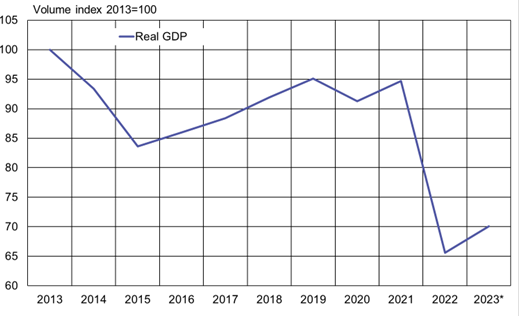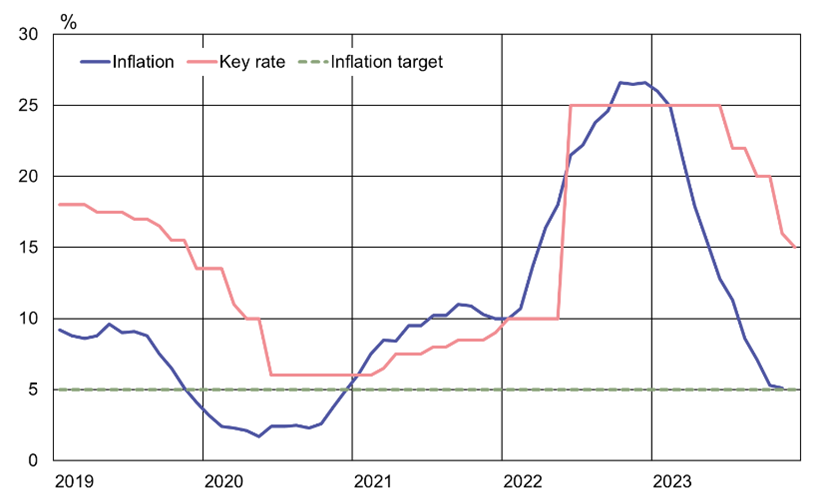BOFIT Weekly Review 01/2024
Uncertainty over foreign aid clouds Ukraine’s otherwise better-than-expected economic performance
Ukraine’s macroeconomic situation relatively stable
Preliminary figures from the State Statistics Service of Ukraine (Ukrstat) show that Ukraine’s GDP grew by 9.3 % y-o-y in the third quarter of 2023. While a slowdown from second-quarter growth of 19.5 %, GDP growth in the January-September period was 5.5 % y-o-y.
High growth largely reflects 2022’s exceptionally low basis, as well as the return of millions of Ukrainians who had fled the country at the start of the war and massive support packages Ukraine has received from other countries and international institutions. Financial assistance from abroad allowed Ukraine to retain price stability and meet the government’s budget financing needs. IMF estimates that Ukraine’s GDP grew by 4.5 % in 2023 and should increase by 3–4 % in 2024.
Ukraine’s real GDP is about a third smaller than before Russia’s illegal annexation of Crimea
* Forecast for 2023.
Sources: Ukrstat, Macrobond, IMF, BOFIT.
NBU lowers reference rate due to falling inflation, abandons fixed peg
12-month consumer price inflation slowed in November to around 5 %, well down from a peak of nearly 27 % in December 2022. Two major factors in reducing inflation last year were the better-than-expected harvest season, especially for fruits and vegetables, and the difficulties in food exports that increased supply in the domestic market. The strengthening of the hryvnia and company expectations of stable forex markets also helped bring down inflation. The rapid subsiding of inflation and inflation expectations allowed the National Bank of Ukraine (NBU) to lower its key rate by one percentage point to 15 % at its rate meeting on December 14.
There are still, however, significant inflation risks. Among the most important drivers of inflation, the NBU points to the course of the war, faster than expected fading of the impact of last year’s good harvest season, as well as Ukraine’s ongoing logistical problems at the Polish and Slovakian borders. Polish lorry drivers and farmers have managed to jam up cross-border traffic since November 6, 2023 with protests e.g. against free movement of Ukrainian lorries in the EU area. Similar protests were also seen at the border with Slovakia in November and December. The losses of Ukrainian export firms since the start of the protests in late 2023 are estimated to be around 160 million dollars, while losses of imports could be nearly 700 million dollars.
With economic conditions stabilising, the NBU in October 2023 eased exchange rate controls and introduced a regime of managed flexibility of the exchange rate. Under the new regime, the official exchange rate will be shaped by the exchange rate used for transactions in the interbank FX market instead of being set by the NBU, but the central bank will continue to control the situation and significantly limit exchange-rate fluctuations. Demand for foreign currencies surged in the initial days of the new regime. The market quickly stabilised, however, and the monthly amounts the NBU has used on forex market interventions has declined since October. In November, the NBU spent 2.5 billion dollars defending the external value of the hryvnia, down from 3.3 billion dollars in October. Foreign support helped boost Ukraine’s foreign currency reserves to 40.5 billion dollars at end-2023.
Inflation has slowed quickly in Ukraine
Sources: Ukrstat, Macrobond, BOFIT.
Positive IMF assessment greenlights immediate release of $900 million in budget support for Ukraine
In December, the executive board of the International Monetary Fund concluded its 2023 Article IV Consultation with Ukraine, as well as its second review of its Extended Fund Facility (EFF) for Ukraine. The country’s EFF funding is conditioned on hitting reform benchmarks as requested by the IMF and reaching indicative economic targets. The IMF assessment notes that Ukraine’s economic figures in most instances exceeded expectations. The released assessment recommends that roughly 900 million dollars in IMF funds earmarked for Ukraine be made available for immediate release. The 48-month EFF programme approved in March 2023 includes 15.6 billion dollars in conditioned assistance to Ukraine. For release of the next tranche, Ukraine needs, among other things, to get final decisions from the EU on loan guarantees. The IMF’s positive assessment was important to the decisions of G7 countries and the Paris club of creditors on postponing payments on Ukraine’s maturing debt to March 2027.
Ukraine’s support needs in 2024 slightly less than anticipated
Ukraine’s 2023 government budget deficit was 1.3 trillion hryvnia (roughly 33 billion euros). The EU’s Macro-Financial Assistance (MFA) mechanism was the largest single source of funds (18 billion euros) to help with Ukraine’s budget shortfall. In addition, Ukraine had issued government bonds worth 540 billion hryvnia (13 billion euros) for the domestic market as of December 15, 2023. In November, the maximum yield on hryvnia-denominated “war bonds” was 18.9 %. The yield dropped slightly from previous months (e.g. 19.2 % in October). Ukraine received direct assistance and low-interest loans from its foreign partners totalling roughly 42.6 billion dollars last year, of which 27 % (11.5 billion dollars) came in the form of direct donations. Nearly all donations (almost 11 billion dollars) came from the US.
Ukraine’s finance ministry predicts that the budget shortfall this year will rise to 1.6 trillion hryvnia (42 billion euros). Due to the relatively good economic performance of the country, Ukraine’s finance ministry estimates that the need for international financial support this year has fallen from 40.3 billion euros to 36.6 billion euros. The support requirement has been reduced by strong demand for government bonds and higher-than-expected tax receipts due to economic recovery.
Finalised assistance commitments for 2024 cover only a tiny part of Ukraine’s overall needs
US 2024 funding for Ukraine remains on hold since Republicans in the US Senate successfully blocked approval of the bill including aid for Ukraine in December. The EU’s 50 billion euro aid package was also blocked in mid-December after it was vetoed by Hungary. The EU now plans to revisit its aid package on February 1. If Hungary continues to block Ukraine funding, the EU still can dip into its 20 billion euro debt facility that does not require unanimous consent from member countries.
The Ukrainian government said in late December that it hopes to receive 18.5 billion euros in support (either loans or direct aid) from the EU budget and 8.5 billion dollars from the US in 2024. Ukraine’s government expects to receive about 5.4 billion dollars in IMF support within the EFF framework this year once it meets its benchmark reform and economic performance targets. The Ukraine government’s financial buffer is currently sufficient to cover running costs through February, leaving little time for Ukraine’s main supporters to finalise their aid commitments.
Just two major supporters of Ukraine, Japan and the UK, have locked in their 2024 commitments. Japan has promised to provide 1 billion dollars in direct humanitarian aid and 3.5 billion dollars via World Bank lending. The UK has committed to maintaining its support in 2024 (as loan guarantees or direct aid) at a level that at least matches the 2023 level (roughly 1 billion dollars). Ukraine is also in talks with countries such as Norway, Canada and South Korea on possible assistance.
Withholding of billions in direct aid to Ukraine threatens its hard-earned macrostability
Thanks to financial support from abroad, Ukraine has avoided spiralling inflation from printing money, which is typical for countries caught up in wars of attrition. Indeed, Ukraine will use every possible means to meet its top spending priorities – funding the war effort and paying out social support. A spike in inflation would have extremely negative consequences on Ukraine’s nascent economic recovery. Ukraine’s finance minister Julia Svyrydenko warned on December 27 that the government would have to postpone pension and public sector wage payments to millions of Ukrainians if foreign assistance did not start flowing by the start of this year.